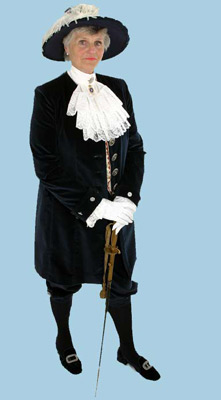 |
Wrington Web Archive High Sheriff of Somerset Sunday, 13th March, 2005 |
 |
Wrington Web Archive High Sheriff of Somerset Sunday, 13th March, 2005 |
 |
||||||
|
Fiona Densham
wearing the ceremonial uniform of High Sheriff of Somerset. One of the traditional ceremonies marking the installation of a new High Sheriff of the county was played out in Wells cathedral on Sunday, 13th March, with the rector of Wrington, the Rev Nicholas Maddock acting as chaplain to the distinguished village resident, Fiona Densham, JP, of Glaisters, as she began her term of office. ~ ~ ~ ~ ~ |
||||||
|
The Office of High Sheriff is at least 1,000 years old, having its roots in Saxon times, before the Norman conquest. It is the oldest continuous secular office under the Crown.
Originally, the Office held many of the powers now vested in HM Lord-Lieutenants, High Court Judges, Magistrates, Local Authorities, Coroners and even the Inland Revenue. The Office of High Sheriff remained first in precedence in the counties until the reign of Edward VII, when an Order in Council in 1908 gave the Lord-Lieutenants the prime office under the Crown as the Sovereign's personal representative. Lord-Lieutenants were created in 1547 for military duties in the shires. The High Sheriff remains the Sovereign's representative in the County for all matters relating to the Judiciary and the maintenance of law and order. Functions of the Office High Sheriffs are responsible in the counties of England and Wales for duties conferred by the Crown through Warrant from the Privy Council, including:- * Attendance at Royal visits to the county; Nominations for High Sheriff Nominations to the office of High Sheriff are dealt with through the presiding Judge of the Circuit and the Privy Council, for consideration by the Sovereign in Council. The annual nominations of 3 prospective High Sheriffs for each county are made in a meeting of the Lords of the Council in the Queen's Bench Division of the High Court of Justice, presided over by the Lord Chief Justice on 12 November each year. The Sheriff's Year The High Sheriff takes up appointment upon making a sworn declaration in terms dictated by the Sheriffs Act 1887. The appointment is for one year only, except in the event of something untoward happening to the High Sheriff's expected successor, in which case a High Sheriff must remain in office until the appointment of a successor is executed. High Sheriffs are now encouraged by the Shrievalty Association of England and Wales to undertake duties to improve and sustain the morale of personnel of voluntary and statutory bodies engaged in the maintenance and extension of law and order and the entire criminal system. In Wells Cathedral The new High Sheriff is formally sworn-in towards the end of March each year. The new High Sheriff is presented in the Cathedral at the Legal Service, giving the opportunity for a prayer of thanksgiving for the past year and a welcome for the year to come. |
||||||
 |
||||||